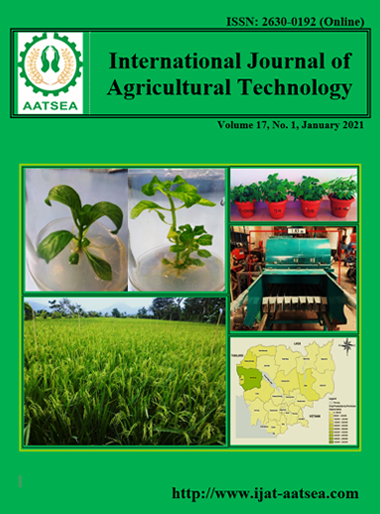Phytoplankton composition in Pacific white shrimp ponds, Phetchaburi Province, upper Gulf of Thailand
Main Article Content
Abstract
Phytoplankton composition in Pacific white shrimp ponds was reported. The results can be used as a guideline for effective management planning of the shrimp farms. The phytoplankton composition was studied at shrimp farm in Phetchaburi Province, upper Gulf of Thailand. A total of 21 species of phytoplankton were recorded. The blue-green algae group was a dominant in terms of the number of species (7 species), and green algae group was a dominant in quantity (90.20% of all phytoplankton), followed by euglenoid (3.70%) and blue-green algae (3.21%). Scenedesmus sp. was the most quantity of all genera in the ponds of this study, with a total density of 147,389.95 cells/liter or 88.73% of the total phytoplankton. In the culture periods, the density of phytoplankton tended to increase along the culture period. The total phytoplankton density had a high level of positive correlation (r=0.994) with statistical significance (p<0.05) with orthophosphate. Moreover, green algae were also highly related (r=0.990) with orthophosphate (p<0.05). Also, the relationship between the ecological index and water quality parameters showed that all ecological index had no statistically significant relationship (p>0.05)
Article Details

This work is licensed under a Creative Commons Attribution-NonCommercial-NoDerivatives 4.0 International License.
References
ACFS. (2016). Guidance on the application of Thai agricultural standard, good aquaculture practices for freshwater animal farm. Ministry of Agriculture and Cooperatives, Bangkok.
Alonso-Rodrı́guez, R. and Páez-Osuna, F. (2003). Nutrients, phytoplankton and harmful algal blooms in shrimp ponds: a review with special reference to the situation in the Gulf of California. Aquaculture, 219:317-336.
Álvarez-Go´ngora, C. and Herrera-Silveira, J. A. (2006). Variations of phytoplankton community structure related to water quality trends in a tropical karstic coastal zone. Marine Pollution Bulletin, 52:48-60.
APHA, AWWA, WEF (2012). Standard Methods for examination of water and wastewater. 22nd ed. American Public Health Association, Washington, DC, 1360 p.
Bhatnagar, A. and Devi, P. (2013). Water quality guidelines for the management of pond fish culture. International journal of environmental sciences, 3:1980-2009.
Burford, M. (2008). Phytoplankton dynamics in shrimp ponds. Aquaculture research, 28:351-360.
Casé, M., Leça, E. E., Leitão, S. N., Sant'Anna, E. E., Schwamborn, R. and Travassos de Moraes Junior, A. (2008). Plankton community as an indicator of water quality in tropical shrimp culture ponds. Marine Pollution Bulletin, 56:1343-1352.
Cremen, M. C. M., Martinez-Goss, M. R., Corre Jr, V. L. and Azanza, R. V. (2007). Phytoplankton bloom in commercial shrimp ponds using green-water technology. Journal of Applied Phycology, 19:615-624.
Dampin. N. (2011). Stocking density model of Oreochromis niloticus in oxidation pond, Royal Leam Pak Bia Environmental and Development Project, Phetchaburi province. (Ph.D. Thesis). Kasetsart University, Thailand.
Funge-Smith, S. J. and Briggs, M. R. P. (1998). Nutrient budgets in intensive shrimp ponds: implications for sustainability. Aquaculture, 164:117-133.
Krebs, C. J. (2001). Ecology: The experimental analysis of distribution and abundance. 5th ed. Benjamin Cummings, San Francisco, pp.816.
Lall, S. P. (2002). The Mineral. In: Fish Nutrition, 3 rd ed. Halver, J. E. and Hardy, R.W. (eds.). California: Academic Press, USA, pp.259-307.
Lucas, R., Courties, C., Herbland, A., Philippe, G., Marteau, A. and Hugues, L. (2010). Eutrophication in a tropical pond: Understanding the bacterioplankton and phytoplankton dynamics during a vibriosis outbreak using flow cytometric analyses. Aquaculture, 310:112-121.
Páez-Osuna, F. (2001). The environmental impact of shrimp aquaculture: Causes, Effects, and Mitigating alternatives. Environmental Management, 28:131-140.
Phinyo, K., Pekkoh, J. and Peerapornpisal, Y. (2017). Distribution and ecological habitat of Scenedesmus and related genera in some freshwater resources of Northern and North-Eastern Thailand. Biodiversitas, 18:1,092-1,099.
Shoko, A. P., Limbu, S. M., Mrosso, H. D. J. and Mgaya, Y. D. (2014). A comparison of diurnal dynamics of water quality parameters in Nile tilapia (Oreochromis niloticus, Linnaeus, 1758) monoculture and polyculture with African sharp tooth catfish (Clarias gariepinus, Burchell, 1822) in earthen ponds. International Aquatic Research, 6:1-13.
Suriyaphan, J. (2014). Role of nutrients on phytoplankton Growth in Intensive Marine Shrimp Cultured. Burapha science journal, 19:227-236.


